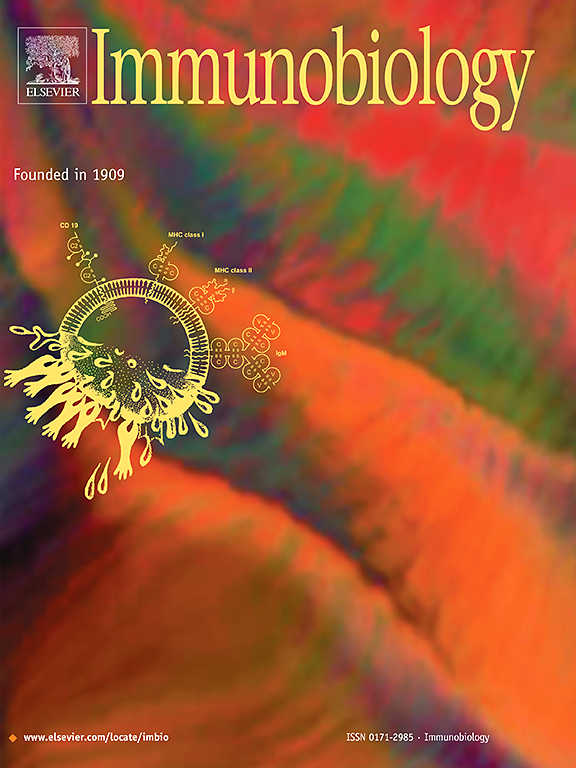A Flow Cytometric Approach to Assess RBC-Bound IgG Antibodies in Different Age Populations
IF 2.3
4区 医学
Q3 IMMUNOLOGY
引用次数: 0
Abstract
Background
RBC-bound IgG antibody-mediated agglutination occurs when red blood cells (RBCs) cluster together due to the presence of antibodies or other contributing factors. This process could be favorable in the elderly population. Not only is it critical for blood typing procedures, but also plays a significant role in autoimmune hemolytic anemia, a condition characterized by escalated destruction of RBCs. Understanding these mechanisms are essential for precise diagnoses, ensuring the safety of blood transfusions, and facilitating laboratory testing protocols in clinical settings.
Objective
This study explores to detect RBC-bound IgG antibodies in various age groups using flow cytometry method.
Materials and methods
A total of 120 Serum samples were taken from different age groups of healthy individuals. In addation, 30 samples were obtained from individuals with autoimmune diseases, and another 30 samples were collected from healthy elderly individuals of the same ages. Serum (100 μL) were added in eppendorf tube containing equal amount of normal saline and 50 μL of 2 % RBC, mixed well and then kept in water bath at 37 °C for 30 min. After incubation, antihuman globulin (AHG) was added and checked for the index of agglutination (IAG) using flow cytometry method. A control sample was also analyzed using the same method.
Results
Flow cytometry analysis revealed significant differences in IAG between younger individuals and the elderly (P-value 0.003), demonstrating a positive linear relationship. Interestingly, no agglutination was observed in the younger group, whereas elderly healthy individuals exhibited agglutination. Furthermore, significant differences were found between autoimmune disease patients and elderly healthy individuals of the same age groups (P-value 0.0001), with strong IAG in autoimmune patients compared to relatively less agglutination in the elderly population.
Conclusion
Our study has successfully detected RBC-bound IgG antibodies in various age groups. Young age groups showed negative IAG while elderly individuals and patients with autoimmune diseases exhibited the presence of RBC-bound IgG antibodies.
流式细胞术评估不同年龄人群中红细胞结合IgG抗体
背景:当红细胞(rbc)由于抗体或其他因素聚集在一起时,会发生drbc结合IgG抗体介导的凝集。这一过程可能对老年人有利。它不仅对血型程序至关重要,而且在自身免疫性溶血性贫血中也起着重要作用,这是一种以红细胞破坏升级为特征的疾病。了解这些机制对于精确诊断、确保输血安全以及促进临床环境中的实验室检测方案至关重要。目的探讨用流式细胞术检测不同年龄人群红细胞结合IgG抗体的方法。材料与方法采集不同年龄组健康人血清120份。此外,从自身免疫性疾病个体中采集了30份样本,另外从相同年龄的健康老年人中采集了30份样本。将血清(100 μL)加入等量生理盐水和50 μL 2%红细胞的epppendorf管中,混合均匀,37℃水浴保存30 min,孵育后加入抗人球蛋白(AHG),用流式细胞术检测凝集指数(IAG)。对照样本也用同样的方法进行了分析。结果流式细胞术分析显示,青年人与老年人的IAG差异显著(p值为0.003),呈线性正相关。有趣的是,在年轻组中没有观察到凝集现象,而老年健康个体则表现出凝集现象。此外,自身免疫性疾病患者与相同年龄组的老年健康个体之间存在显著差异(p值0.0001),自身免疫性疾病患者的IAG较强,而老年人群的IAG凝集相对较少。结论本研究成功检测了不同年龄人群的红细胞结合IgG抗体。年轻人群IAG呈阴性,而老年人和自身免疫性疾病患者则存在红细胞结合IgG抗体。
本文章由计算机程序翻译,如有差异,请以英文原文为准。
求助全文
约1分钟内获得全文
求助全文
来源期刊

Immunobiology
医学-免疫学
CiteScore
5.00
自引率
3.60%
发文量
108
审稿时长
55 days
期刊介绍:
Immunobiology is a peer-reviewed journal that publishes highly innovative research approaches for a wide range of immunological subjects, including
• Innate Immunity,
• Adaptive Immunity,
• Complement Biology,
• Macrophage and Dendritic Cell Biology,
• Parasite Immunology,
• Tumour Immunology,
• Clinical Immunology,
• Immunogenetics,
• Immunotherapy and
• Immunopathology of infectious, allergic and autoimmune disease.
 求助内容:
求助内容: 应助结果提醒方式:
应助结果提醒方式:


